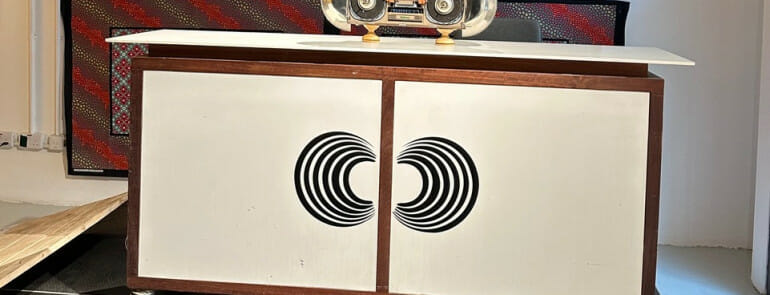In the hushed corridors of history, certain moments linger as resonant echoes forever etched in our collective memory. Kenya’s 1982 coup d’état attempt is one such moment—a pivotal turning point that continues to reverberate through time. Now, an art installation titled ‘Amplitudes of Dawn’ transports us back to that fateful night and invites us to embark on an auditory odyssey like no other.
Nestled within the creative enclave of the Goethe Institut, ‘Amplitudes of Dawn’ takes its inspiration from the radio announcement that changed the course of Kenya’s history. Curated by down river road and friends, this multi-dimensional exhibition transcends the boundaries of traditional art, fusing soundscapes, visual art, installations and interactive experiences into a tapestry of historical reflection and contemporary expression.
At the heart of this mesmerizing exhibition lies the notion of “counter/listening”—a journey through time, a witness to the injustices of the past and present and a path towards healing, awareness and dissent.
The Sonic Craftsmanship of Cyrus Kabiru
Stepping into the exhibition space, one is immediately captivated by the meticulously crafted radios of Cyrus Kabiru, a series aptly named ‘The BBC Era.’ These evocative artworks unveil the sonic inheritances of that tumultuous 1982 ‘hiccup,’ juxtaposed against the deafening silence that followed the coup’s aftermath. Kabiru’s work speaks volumes about the power of art to make visible the hidden layers of history.

Onyis Martin’s Talking Walls
Onyis Martin, another luminary of this sonic odyssey, offers us a psychogeographic glimpse of Nairobi’s walls. Through his ‘Talking Walls,’ he transforms the city’s façades into a living museum, each wall narrating tales of command and caution. As we stand before these urban canvases, we are reminded of the city’s silent commands: “Do not stand in front of the gate.”

Kamwangi Njue’s 82 Decibels/ Nduru
Kamwangi Njue weaves a sonic quilt of 1980s-era sounds, culminating in the clamor of the coup attempt. In ‘82 Decibels/ Nduru,’ Njue encapsulates the chaos, the uncertainty, and the raw emotion of those pivotal moments in Kenyan history. It is a journey through sound that immerses the listener in the past’s echoes.

Punctum / Fimbo ya Nyayo
The aftermath of the coup was marked by trials, where over twelve people were sentenced to death for treason and hundreds more were jailed. The pain, the loss and the cries of injustice wish to be heard. ‘Punctum / Fimbo ya Nyayo’ captures the dirge, the elegy, and the funerary lament through the voices of those who remember. Memories harvested from online comments are shared, spoken aloud and passed from one listener to another.
If you choose, you can have a sit and listen to stories of people experienced the coup first hand, there is a pair of headphones with your name on it.

In Common Bond / Stori za Jaba
In the sonic landscape of ‘In Common Bond / Stori za Jaba,’ we are confronted with a question: What is the sound of Kenyan (counter) patriotism today? Within this space, we are free to fantasize, to fabulate. Here, we dare to dream and express our wildest imaginings of another Kenya. The DJ booth beckons, confessions are made, manifestos are recorded, and wild visions of the future are voiced.

Anthony Muisyo’s Visual Narrative
Anthony Muisyo weaves together a visual narrative of August 1st, 1982. His work transports us to that fateful night, where uncertainty hung heavy in the air. He attempts to recreate the living rooms that contain the memories of this tragedy, I was taken back to that moment while looking at this old furniture and I tried to imagine what it was like when the families heard about the coup on the radio. Through Muisyo’s eyes, we witness history unfold, not in the pages of a textbook, but in the vibrant strokes of his art.

As I meandered through the ‘Amplitudes of Dawn’ exhibition, I was reminded that history is not a stagnant entity. It lives and breathes through the voices of those who remember and the artists who give those voices new life. This exhibition is a testament to the enduring power of art to make us bear witness, to heal and to awaken.
One cannot help but reflect on the tragic events of August 1st, 1982, when a coup attempt left a trail of devastation in its wake. The University of Nairobi closed temporarily, the Kenya Air Force disbanded and the nation grappled with the aftermath of violence. Over a hundred soldiers and two hundred civilians lost their lives, and thousands were arrested. The economic losses were staggering, ranging between $111 and $500 million. It was a period of uncertainty that the nation will never forget.
The ‘Amplitudes of Dawn’ exhibition is a collaboration that transcends artistic boundaries. Down River Road, Magic Door and Goethe Institut’s Sasa Nairobi Exhibition series have come together to offer a unique and immersive experience. It’s a journey that not only transports us to the past but also invites us to imagine alternative realities and soundscapes for the future.

As you step into the Goethe Institut, remember that ‘Amplitudes of Dawn’ is not just an exhibition; it’s an invitation to bear witness, to contemplate and to heal. Come as you are, and let the echoes of history guide you through a sonic journey like no other. The exhibition runs until September 13th, so, there’s ample time to embark on this transformative experience and entry is FREE.
In the midst of silence and sound, ‘Amplitudes of Dawn’ reminds us that art has the power to transcend time and offer new perspectives on our shared history. It is an exhibition that invites us to listen, reflect and imagine—a powerful testament to the enduring legacy of the 1982 coup in Kenya.

